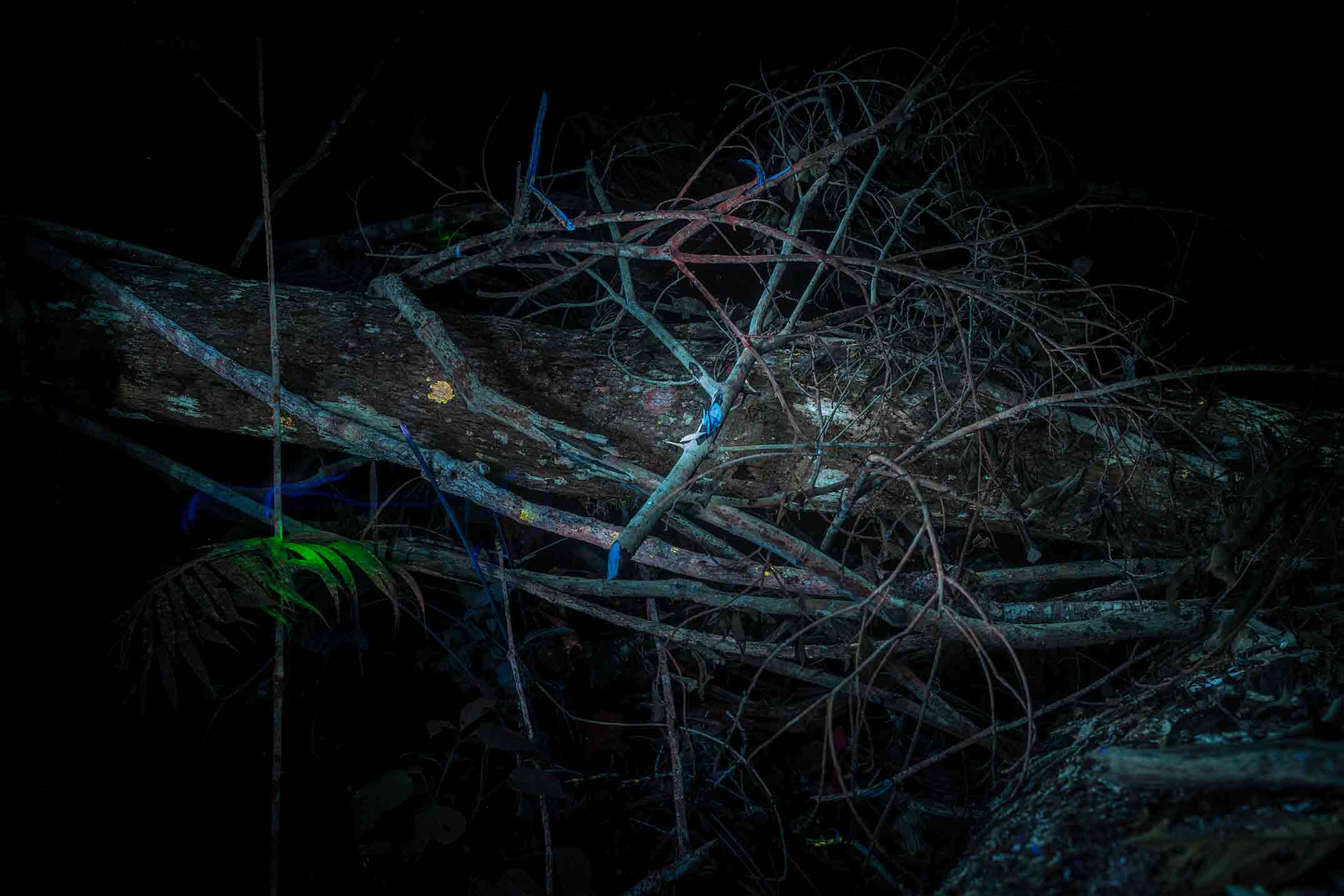
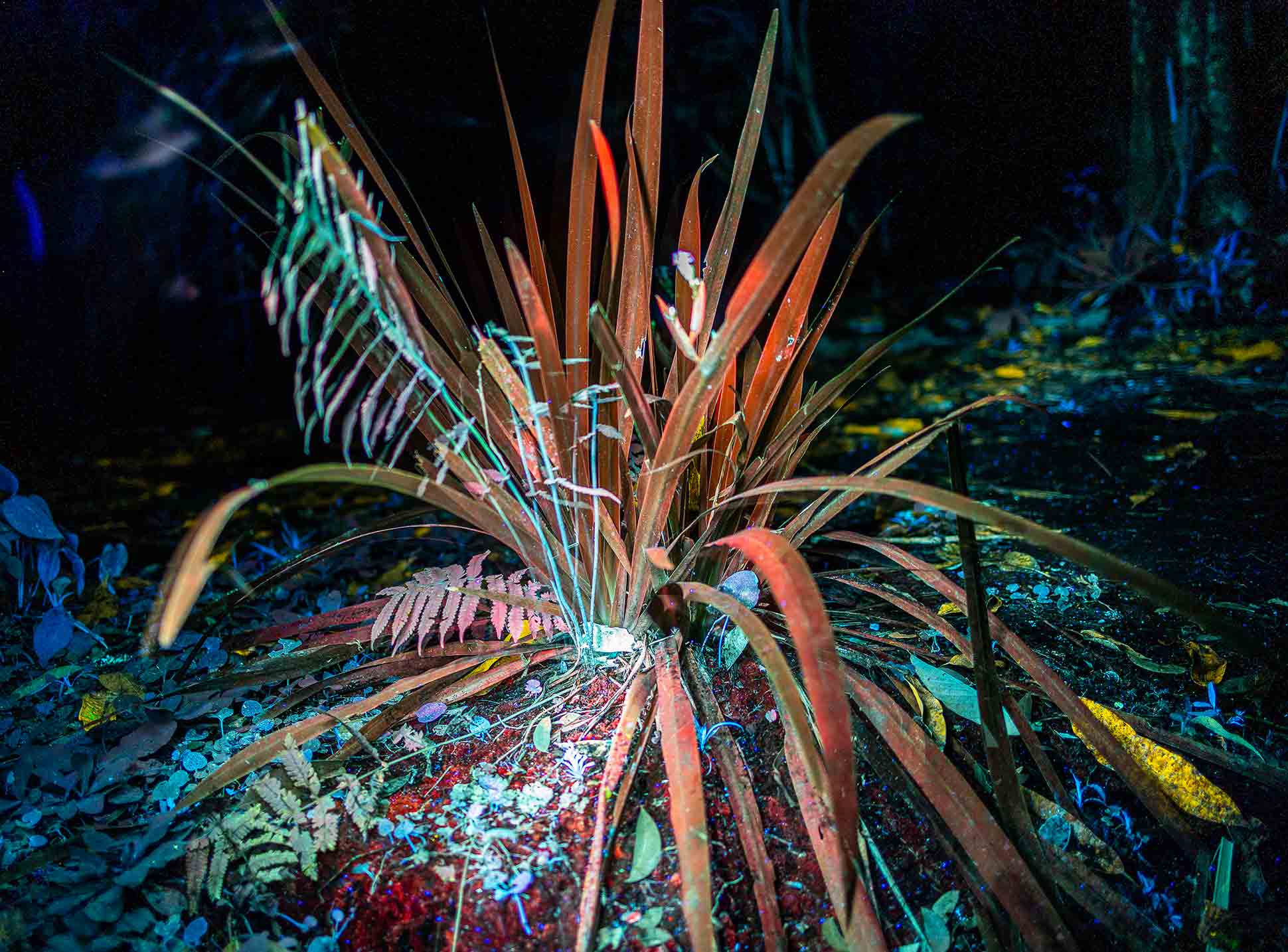
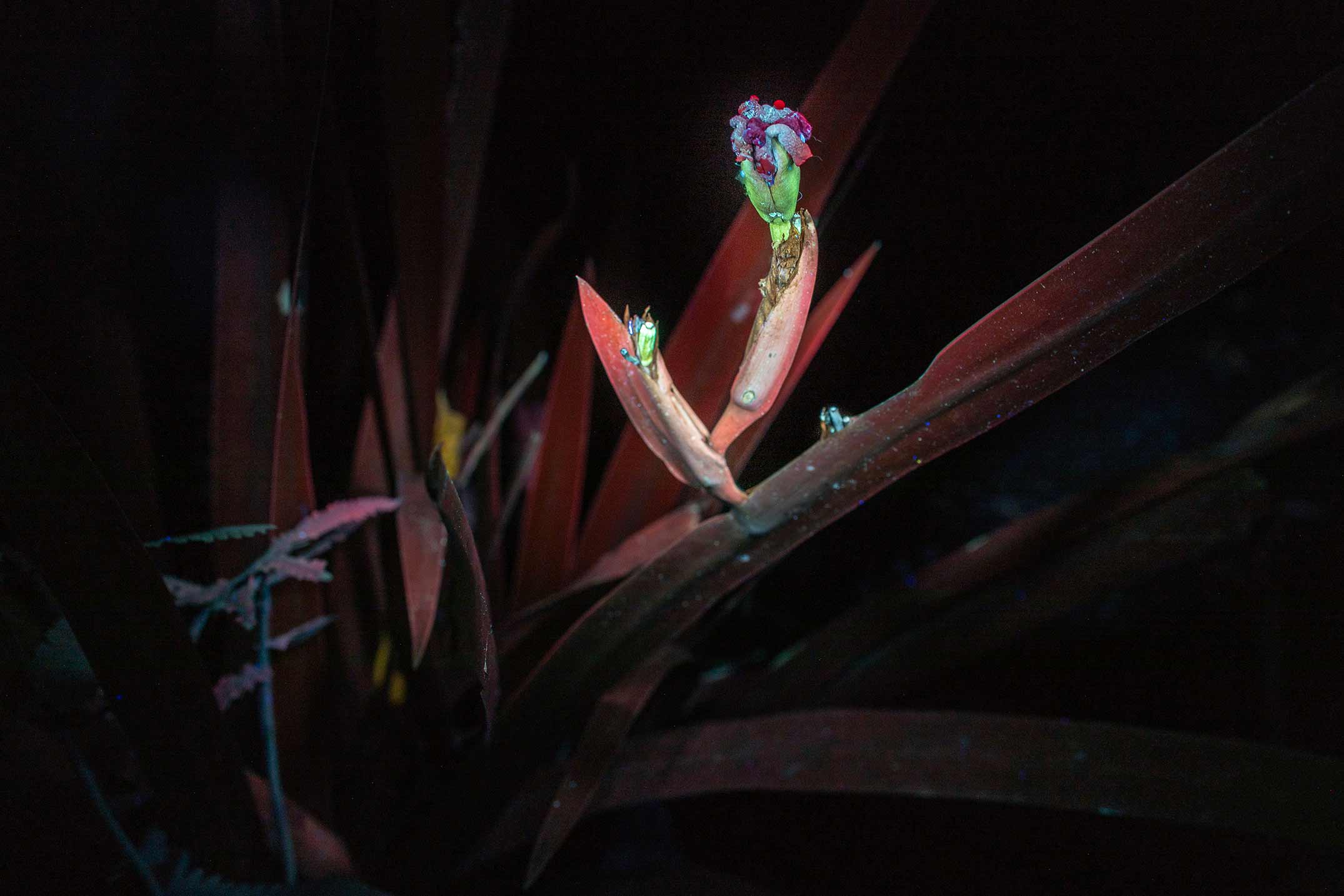
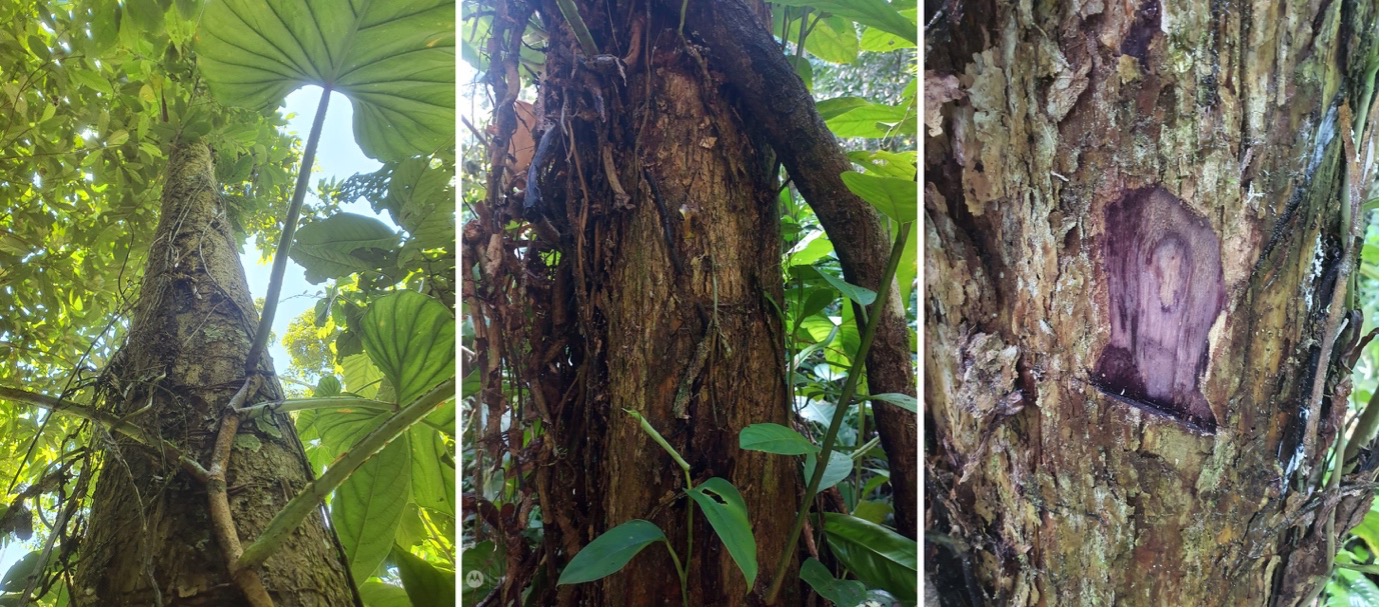
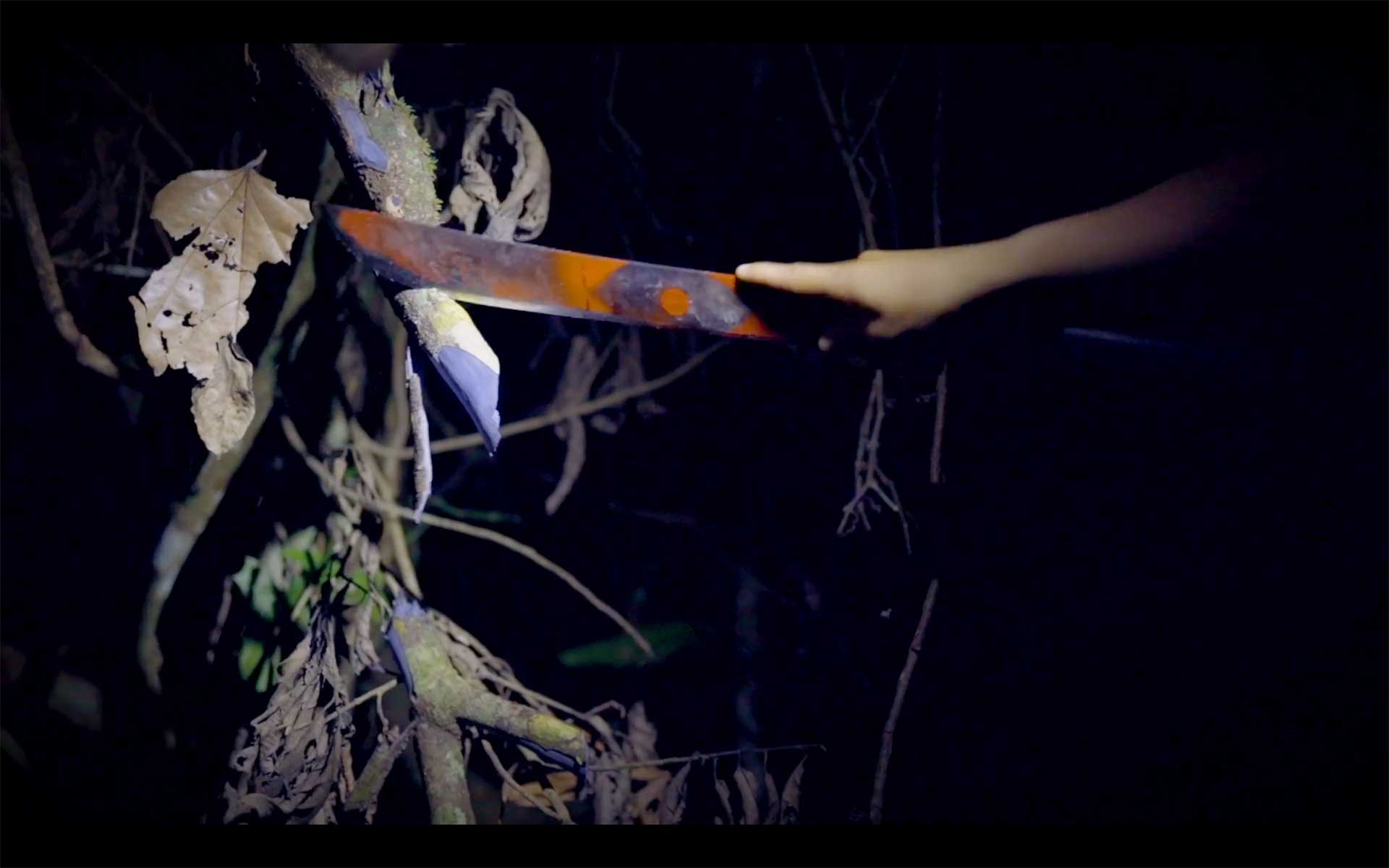
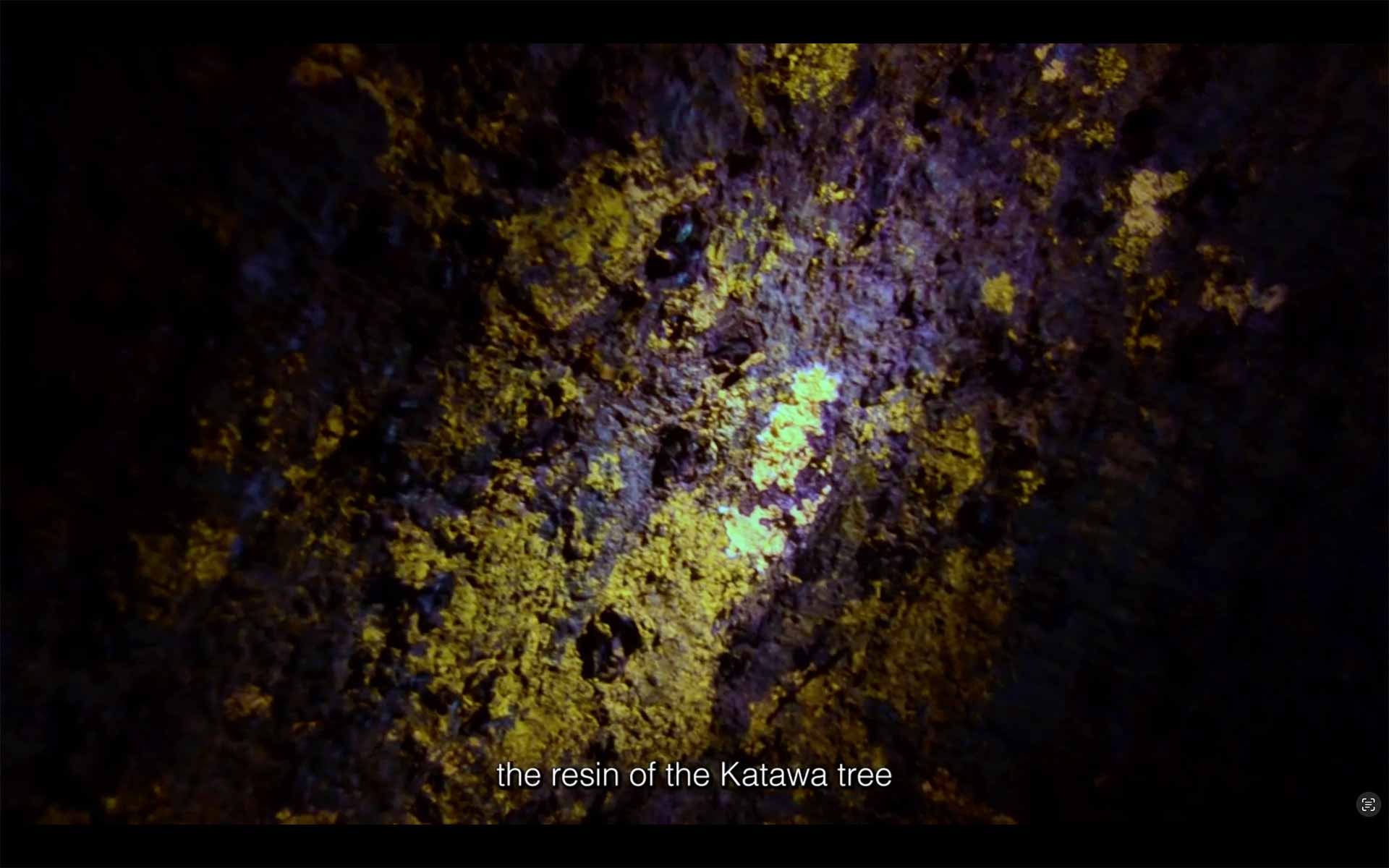
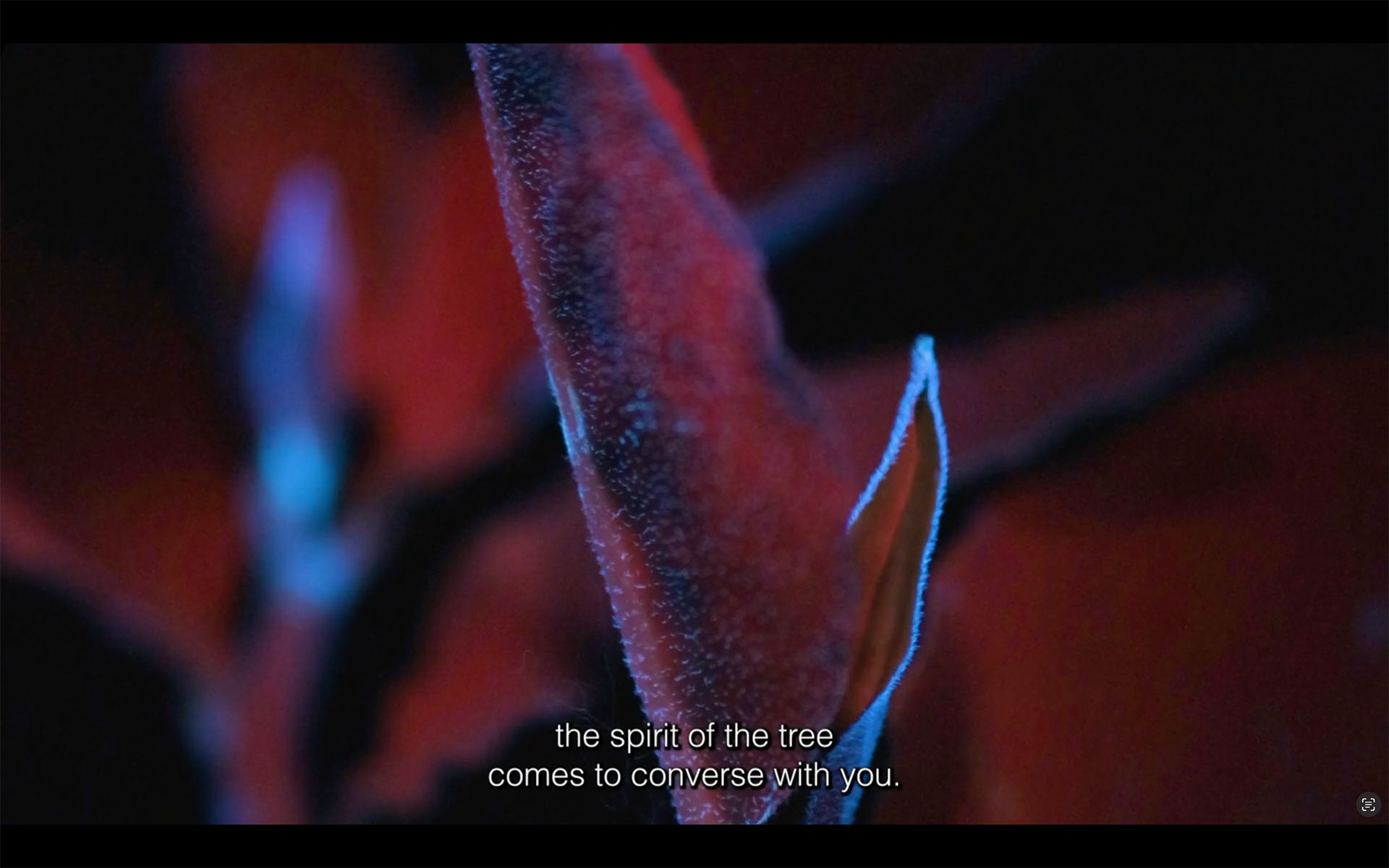
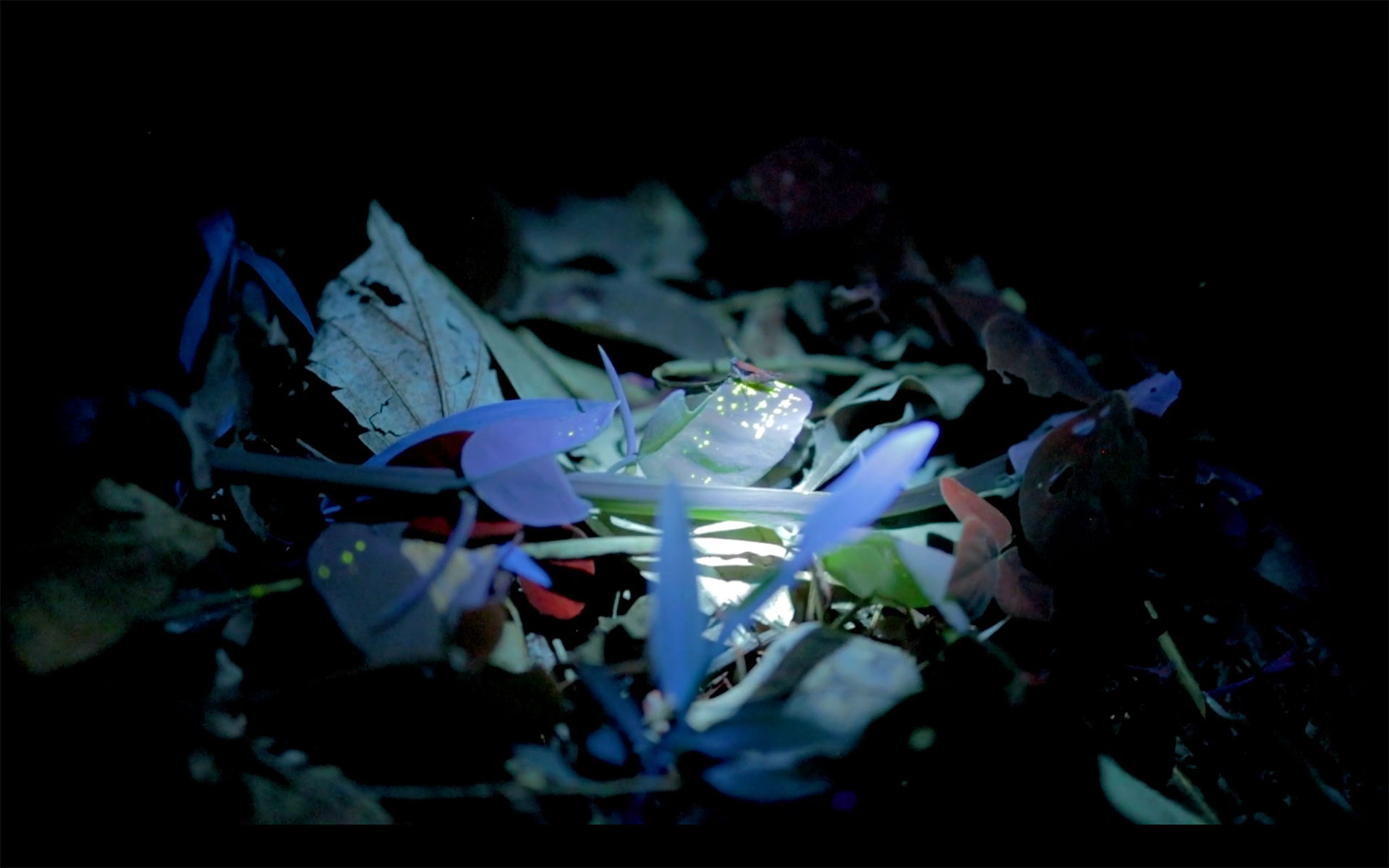
Along the Ecuadorian latitudinal line, the sun sets a few minutes after 6 p.m. and rises shortly beofre 6 a.m. every day and during every season. Thus, the daily life of the Amazon rainforest is split halfway between day and night. After the sun sets and vast shadows envelop the undergrowth, green becomes only a color that beguiles the human eye.
Light in the rainforest manifests in full spectrum and for plants, this energy is material to be transformed into the chemestry that sustanins life. Fluorescence appears when absorbed light is then re-emitted from a plant, following the change of chlorophyl molecules from excited to non-excited state. Thus, under the canopy of the Peruvian Amazon in Madre de Dios, plants like bromeliads or even pineapples have gained an advantage in the competition for light and resources by adapting their circadian and metabolic rhythm to feed from light during the day, and to process minerals and exchange gases at night (known as photosensitises CAM [1]). Meanwhile, neighbor plants perform a sort of contacless dance to repostion their leaves in accordance to the coming sun rays but also the light emitted back from one plant onto another. For plants, light is a source but also a byproduct and there are many ways to pick up this signal. As Stephano Macucos writes:
The way our retinal apparatus perceives the world around is based on the same principle throught which a plant ‘sees’ its environment through light receptors. That is through light reflected on certain surfaces, but also emitted by other surfaces among them the plant’s leaves. In other words, if we could switch off the sun like we do with a light bulb, the forest would not go immediately dark but instead, a faint light coming from leaves, flowers, pollen, or fungi attached to various parts of the plant would glow with fluorescence tones. Still, this signal might not be very strong to be perceived by the naked eye but for some insects and animals, or cameras equipped with the right filters, this cannot go unnoticed.
Chlorophyl is the pigment that sits inside the cell’s chloroplast, which are the organs responsible for harnessing energy from light. When Chlorophyl molecules are excited by light, even at dusk, these molecules release residual energy in the form of fluorescent light, often in various tones of red. However, since chlorophyl is not free-floating in the chloroplast but instead, it is embedded in the membranes within proteins, or trapped in the antenna complex, the red color can be dimmed by waxy cellulose. In this instance the color emitted from the plant becomes closer to blue or deep purple. Decomposing leaves on the contrary, some of which host fungi or lack chlorophyl, tend to emit brighter colors in the green and yellow hues. In the forest, these can be spotted easily even under moonlight feeding superstition and speculation among locals and unsuspected visitors.
The human can only perceive light between the 400 and 700 nm range of the electromagnetic spectrum but lower frequencies affect plants in different ways. UV-A, or ultraviolet frequencies between 320 to 400 nm stimulate metabolic and morphological process in plants, including photosynthesis and biomass production [3].
Therefore, when lit with artificial lighting in the UV-A range, the plant absorbs as much energy as it needs but emits back the excess energy either as heat or fluorescence. This process is often used to monitor photosynthetic efficiency and asses the contribution of a given plant in ecosystemic services [4]. However, to my knowledge, the method doesn’t yield results in uncontrolled conditions like the ones I found in the Peruvian rainforest back in September 2022, a fact which for me frees the technique from a prescribed scientific agenda and makes it available for artistic appropriation.
Equipped with a multispectral digital camera, a set of UV and IR blocking filters, and portable UV lamps with a wavelength of 365 nm, I entered the rainforest aiming to see un the unseen. What I stumbled upon was the inner rhythms of plants at night, expressed in varying degrees of fluorescence and heavily entangled links with fungal life. As a result, the images I recorded are at the threshold of vision. While the human eye can hardly see the light that plants emit and my digital the camera performed more like a wishful pinhole camera stuck in very long exposures without a visual reference, the subtle inner glare of plants pierced my mind and boycotted any attempts at decoding -with reason- what I was seeing. When trying to articulate the experience of encountering the Amazon rainforest at the darkest hours of the night, I can only attest that the rainforest at night becomes totally radiant, even within the darkest corners.
Insects and animals, outfitted with more potent visual organs use the night to feed; plants express their state of being through the release of heat, humidity, light and scents; fluorescent fungi iluminate the path toward decomposing piles of forest debries; and local shamans use the long night hours to learn from plants and to ‘see’ through them how to cure the illness of the body and of the land. As counterintuitive as this might be, to engage with the dark forest as a luminous place full of 'seeing' plants, demands attentiveness to other signs and ways to articulate dual life-sustaining relations.
First and foremost, understanding a plants’ capacity to 'see' needs to be decoupled from the visual determinism of our human visual culture, for plants do not need an "image-forming organ." [5] Second, the visions enabled by plants (through their chemical interference with neurotransmitters in the human brain) is less about forming an image of an object, for example a plant spirit or a non-human forest dweller, as much as seeing through it. As anthropologist Dr. Luis Luna puts it:
This form of knowing through plant-induced visions, which I can say from experience correlates immensely to the images I captured of the forest at night can be a form of 'Vegetal Enlightenment'. A kind of reasoning that is not entirely cognitive but more like an intestinal, vomitive and even purgative process, as opposed to a rhetoric practice that relies on interlinked ideas. Most importantly, 'Vegetal Enlightenment' might be a form of thought not concerned with shining a light of knowledge onto something obscured by unknowns but instead, sensitive to the faint signs and signals coming from the world we often ignore, like the radiance of the rainforest forest at night .
This mode of 'Vegetal Enlightenment' that I argue for does not happen within the brain or is limited only the huma body. Instead, it lays in the relations we establish with the plants that provide energy, remedy or even sickness to our bodies. After all, what happens to plants also happens to us. In this regard, plants not only transform light into energy but they also energize us so we can too, perceive light traces from within. Through ingestion, contact or breathing, plants warn us, they prepare us and ultimately, they heal us to the point of transformation.
Therefore, the aim of this sub-strand of the project I call Detrás de la Noche (Behind the night) is two-fold. On the one hand, it strives to bring to light the life of plants at night, crisscrossing layers of invisibility to capture (in photography and video) the subtle and often sub-visible energy gesturing and self-expression of plants. Among these are a series of unedited photographs made with induced fluorescence in the rainforest during moonless nights of the dry season, which render the rainforest as a slightly otherworldly landscape and place crucial trees and shrubs of the rainforest as central characters.
On the other hand, by pushing the IUVF (induced UV Fluorescence) technique even further to record video at night, I explore the spiritual dimension and mysticism attributed to the encounter with plants at night. Thus, following the accounts of two Amazonian men devoted to plants, one in Peru and the other in Colombia, the film opens a door into the issue of human-plant communication through a cautionary tell of how plants deceive, conceal and deliver cures or illness at their own will.
These works were produced in two locations. The first is the Amazonian Center of Experimentation (CEA) in the outskirts of Mocoa City in the Andean-Amazon foothills of Colombia. This place is home to well-preserved botanical garden of several medicinal plants often used by indigenous healers of the Andean-Amazon region, currently at risk of disappearance because the expansion of extractive projects and internal civil war. For Inga and Kamnëstá shamans, spirits take the form of plants and plants act like spirits, pulling humans closer to their hidden worlds where medicinal plants tell the healer how to cure This often leads to a sort of plant-led healing multistep program, where cleansing the human gut is the first step.
The other location is Camino Verde Reforestation Station, on the banks of the Tambopata River in the Madre de Dios region of the Peruvian Amazon. The area is a living seed bank, and a hugely important buffer zone where endangered Amazonian plants and trees are given space and time to thrive. A few kilometers from the reserve are one some of the biggest open pit mining sites of the Amazon, making Camino Verde an important player in the conservation efforts of the Peruvian Amazon.
Among their many endangered species is a tree, for now identified as almendrillo (Calatola costaricensis Standl., from the Metteniusaceae family), which to some degree might be one of the rarest trees of the rainforest. Endemic to Colombia, this tree belongs to small family with only 52 species recorded. The specimen we found at Camino Verde (CV) has the peculiarity that its wood turns blue when the bark is removed or cut open, and the color becomes even stronger overnight. Its effect might be caused by oxidation, which connects to its photosynthetic activity throughout the day but what is most intriguing is that such tree is elusive and could only be spotted with the UV-A lamps.
Perhaps because of mimicry, this tree can be seen but not remembered. It’s a tree that has puzzled several tropical plant experts I contacted to help me identify it because it displays many similarities with two or more species, and no one had ever seen a specimen with such distinctive coloration. Without seeking too many precisions but instead honouring the mystery, the almendrillo tree we found at CV becomes another character in the film, perhaps one that is suspended somewhere between fact and fiction.
For me, the questions that bear attention are not so much about the phytochemistry that makes the tree blue, but instead, why does the tree give us such a clear indication of its presence at night?; what could it be trying to express about itself and its surrounding?; and finally, can this tree help us to lift the veil assumptions that drive our visual culture and to challenge the supposed greenness of nature in order to embrace the forest in its full scale of color, vibrancy and potential to re-enlighten society?
2The Revolutionary Genius of Plants: A New Understanding of Plant Intelligence and Behavior. Stefano Mancuso. Pg 96
3https://www.intechopen.com/chapters/85608
4https://climexhandbook.w.uib.no/2019/11/03/chlorophyll-fluorescence/
5 Paco Calvo. Planta Sapiens, Pg. 125.
6Excerpt from the recording of the keynote at Hardvard Divinity School Lecture Series. February 16, 2024 https://www.youtube.com/watch?v=Hz2PDnoSJq8



